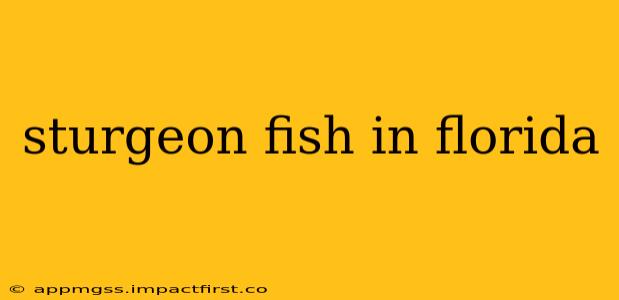Florida's diverse aquatic ecosystems are home to a fascinating array of fish, and among them, sturgeon stand out as ancient, impressive creatures. Understanding these fish, their habitat, and conservation efforts is crucial for preserving these magnificent animals. This guide delves into the world of sturgeon in Florida, addressing common questions and providing valuable insights.
What Types of Sturgeon Are Found in Florida?
Florida boasts two primary species of sturgeon: the Atlantic sturgeon (Acipenser oxyrinchus) and the shortnose sturgeon (Acipenser brevirostrum). Both are anadromous, meaning they spend most of their lives in saltwater but migrate to freshwater rivers to spawn. The Atlantic sturgeon is significantly larger, reaching lengths exceeding eight feet, while the shortnose sturgeon is smaller, typically remaining under four feet. Distinguishing them requires careful examination of their body shape, snout length, and other physical characteristics—a task best left to experienced ichthyologists.
Where Do Sturgeon Live in Florida?
Sturgeon in Florida inhabit various waterways, primarily focusing on larger rivers and estuaries. Atlantic sturgeon are more widespread, utilizing systems like the St. Johns River, the Suwannee River, and the Aucilla River for spawning. Shortnose sturgeon tend to have a more restricted range, often found in smaller tributaries and coastal areas. Their precise locations are often kept confidential to protect these vulnerable populations from disturbances.
Are Sturgeon Endangered in Florida?
Yes, both Atlantic and shortnose sturgeon are considered endangered or threatened species in Florida and across much of their range. Decades of overfishing, habitat destruction, and water pollution have decimated their populations. This necessitates stringent conservation efforts to ensure their survival. Therefore, encountering a sturgeon is a rare and remarkable event.
What are the Threats to Sturgeon in Florida?
Several interconnected factors threaten Florida's sturgeon populations. These include:
- Overfishing: Historically, sturgeon were heavily targeted for their meat and roe (caviar), leading to significant population declines.
- Habitat Degradation: Dam construction, dredging, and coastal development have destroyed crucial spawning grounds and altered essential habitats.
- Water Pollution: Runoff from agriculture and urban areas introduces pollutants that degrade water quality and impact sturgeon health and survival.
- Entanglement in Fishing Gear: Sturgeon can become entangled in fishing nets and other gear, leading to injury or death.
What is Being Done to Protect Sturgeon in Florida?
Various conservation initiatives are underway to protect Florida's sturgeon populations. These include:
- Strict Fishing Regulations: Size and bag limits, along with gear restrictions, are in place to protect sturgeon from overfishing.
- Habitat Restoration: Efforts are underway to restore and protect crucial spawning grounds and habitats.
- Research and Monitoring: Scientists continuously monitor sturgeon populations and conduct research to understand their ecology and improve conservation strategies.
- Public Awareness Campaigns: Educating the public about the importance of sturgeon conservation is critical to long-term success.
Can You Eat Sturgeon in Florida?
No. Due to their endangered status, catching and consuming sturgeon is strictly prohibited in Florida. Heavy penalties apply to those who violate these regulations. The focus is entirely on protecting these ancient fish for future generations.
What Happens If You Catch a Sturgeon in Florida?
If you accidentally hook a sturgeon while fishing, it's crucial to immediately and carefully remove the hook, minimizing stress and injury. Do not attempt to keep the fish. Instead, immediately report your encounter to the Florida Fish and Wildlife Conservation Commission (FWC). Their expertise and guidance are essential for ensuring the well-being of the sturgeon.
Conclusion
Florida's sturgeon represent a vital part of the state's natural heritage. Understanding the challenges they face, the conservation efforts underway, and the importance of responsible stewardship is key to ensuring their survival. By continuing to support research, conservation initiatives, and sustainable practices, we can help protect these magnificent creatures for years to come.
